Text
The Rocky Horror Picture Show: a search for identity through a camp movie
«Don't get strung out by the way I look! Don't judge a book by it's cover / I'm not much of a man by the light of the day / But at night I'm one hell of a lover» These words sung by Tim Curry in «Sweet Transvestite» perfectly summarizes the central topics of The Rocky Horror Picture Show. This 1975 movie, which mixes horror, SF and musicals, is now seen as a cult movie. Today still, some theatres project the movie where the audience come dress up as the characters for singing along with them. It allows us to talk about this film as a camp movie. We can link the idea of camp to artifice, stylisation and exaggeration. These three words can also describe The Rocky Horror Picture Show. The Rocky Horror Picture Show changed something in cinema but also in society. This movie represents a sexual revolution. The main character is a transsexual, alien nymphomaniac who kills his former lovers. It's not only a B movie which wants to make fun of Hollywood cliché. It's also a strong political discourse about sexuality and the way it's represented in the media. In fact, The Rocky Horror Picture Show is a satire of cinema and American society in the 70s.
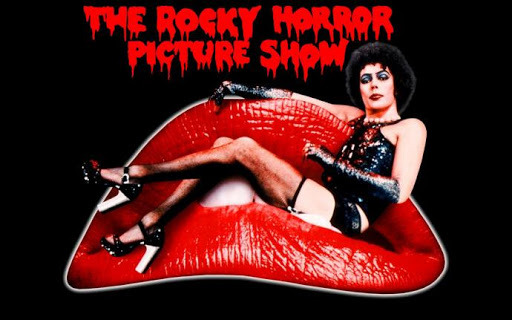
We can talk of The Rocky Horror Picture Show as a camp movie. Indeed camp can be linked to artifice and stylisation but also to the highlighting of unusual figures here. First, the movie comes from the idea of artifice with stereotyped characters. Brad and Janet as the white middle-class couple for example. The characters are presented as stereotypes of the movie genre they're representing: Janet and Brad represent the musical, Riff Raff and Magenta represent horror and Frank-N-Furter and Rocky represent science fiction... But what's the most interesting in this movie is the performance of unusual characters, which can be seen as an illustration of camp. Indeed, we have a lot of unexpected characters. Frank is a transsexual alien, Riff Raff appears as the hunchbacked sidekick. Even Brad, doesn't entirely match the norm of masculinity. He appears as a nerdy, clumsy guy; other characters laugh at him when he's in his underwear because he appears «common». The Rocky Horror Picture Show really focuses on uncommon bodies, which are usually seen as imperfect but here they are exalting. This movie is celebrating what is usually seen as weird and unconventional. Also, the mix of genres such as horror, science fiction and musical take part in the construction of a camp movie. The directors mixed these three styles to create a sensational story about a transsexual alien who succeeds in creating the perfect lover. The musical gives a kind of «kitsch» aesthetic to the movie. Everyone is always singing and dancing even when the action is kind of dramatic. This frivolity is counterbalanced by the horror style. We can talk about the scene where Frank kills Eddie. Just before the murder, Eddie is doing a rock'n'roll show but Frank can't handle his presence so he becomes violent. We have then a high-speed car chase, strengthened by shots-reverse-shots on Eddie's face, Frank's face and Columbia's face. Then Frank is filmed in a low angle-shot to represent his power and madness. In this moment we're in a horror movie. Finally, the science fiction genre is always in the background of the movie. The residents come from «Transsexual Transylvania» and at the end the house takes off to go back to Transylvania with poor special effects. The Rocky Horror Picture Show can really be seen as a turning point in cinema. Even if it's labelled as a B movie, it was a very daring project, not only in terms of movie genre but also in the society's representations.
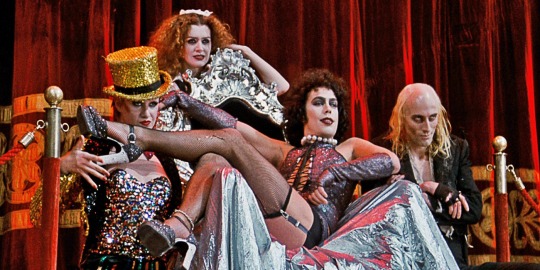
In fact, The Rocky Horror Picture Show takes a social turn by representing a lot of sexualities; which is revolutionary for the 70s. The movie wasn't scared to break the norms. For example, the presentation of Brad and Janet as a perfect hetero couple is just an outward appearance because later on in the movie both of them will sleep with Frank-N-Furter. With the same pattern, Frank goes to Janet's bedroom then to Brad's bedroom. He sneaks in, starts to arouse them by pretending to be Brad or Janet, they realize it, try to resist but in the end their sexual desire appears to be stronger and they sleep with Frank. Within five minutes, we have examples of heterosexual and homosexual relationships; which also means a subtext of bisexuality for Frank-N-Furter. Even today, bisexuality isn't often represented, so it really appears as a revolution in The Rocky Horror Picture Show. In the movie we're also confronted with the idea of voyeurism. Indeed, when Frank and Brad are sleeping together, we can see them on a TV screen, just like Janet who saw everything. And, a few moments later when Janet is having sex with Rocky she's also watched by Magenta and Columbia. And at the same time, we have a subtext of masturbation because we have shots-reverse-shots of Janet and Rocky having sex and of Magenta and Columbia watching them, singing, playing with a hairdryer. Nothing is clearly shown, but the subtext is really there. Finally, we have an evolution of Janet which places the women at the center of sexual pleasure. Indeed, the scene where she has sex with Rocky is only about her. We have a lot of close-ups on her face clearly showing pleasure, plus the song at the moment is «Touch-A, Touch-A, Touch Me»; I mean it would be hard to deny what this whole moment is about. She's also the one taking things in hand, leading Rocky. She's now the center of attention, putting her desire first forgetting what society considers correct or not by having sex before getting married and not with the man she's supposed to marry. So, The Rocky Horror Picture Show shows taboo themes for the time, mostly linked to sexuality. It clearly breaks the norms of the time, saying that everything is possible and that's okay. And all of that is only possible precisely because we are in a camp B movie. Here, the genre serves the idea.
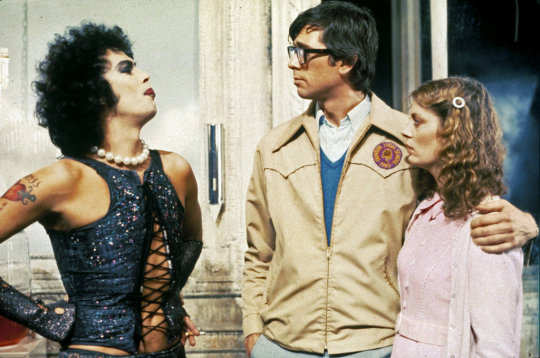
Finally, The Rocky Horror Picture Show represents a search for identity. First of all, most of the characters have duality in them. What's funny is that Brad and Janet best highlight this. They're constantly torn between norms and transgression. At first, we are presented to them as the perfect heterosexual white couple but throughout the movie they're the two characters who question the most their identities. They both slept with Frank; Janet also sleeps with Rocky. They're discovering themselves and each other at the same time as they're discovering the house. What can appear surprising is that Frank-N-Furter is also full of duality. Even if at first he appears really sure of himself, he isn't. He's divided between his eccentricity and his fear of loneliness. Indeed, if Frank is always changing lover it's because he's afraid people will fall out of love with him. The creation of Rocky - as the perfect lover, muscular and not thinking much – is a way for Frank to assure himself he will always be loved. That's why he goes insane when he learns that Rocky and Janet slept together. His desire to have control and power over everyone is lead by his fear of loneliness. The fact that he can't even control Rocky breaks him. The frivolity of Frank highlights duality, but also the journey to the acceptance of oneself.
The fact that the characters are tirelessly searching for their real self is a means to promote acceptance in modern society. At the end, with the «Rose Tint My World» scene, the characters come to terms with their duality. In the song, each character does the inventory of his life, highlighting the ambiguity of their emotions toward Frank and themselves. The camera follows the choreographies of each character, alternating close-ups, medium shots and low-angle shots. Then Frank appears in the middle with triumphant music in the background. He tells his own story, «Don't dream it. Be it.». Frank is the figure of acceptance. In this scene, everybody is dressed the same way as Frank. We can see this as an illustration of Frank's narcissism but also as an illustration that they can be what they want, no matter the norms around them. Arrives the pool scene where we have again strong sexual representation but against a backdrop of acceptance, forgiveness and fulfilment. But, at the same time Riff Raff and Magenta interrupt the moment to announce that Frank has failed his mission and that he can't stay on earth. This can be seen as an intervention of social norms against the movement of acceptance because the justification of Frank's murder is that «society must be protected». Riff Raff and Magenta become a metaphor for a social norm, which wants to destroy the root cause of a possible revolution.
The Rocky Horror Picture Show is an emblematic movie, which deals with sexual emancipation and, on a larger scale, with a search for identity. By putting unconventional characters in the spotlight and by corrupting «classical» characters, the movie decides to support a new vision of modern society. The camp characteristics of the movie help it to interrogate the actual definition of gender, sex and what is socially acceptable or not. Taking the form of a «B movie» only allows the directors to create a movie which can openly criticize social and political norms and support a revolution in representation and sexual definition. The Rocky Horror Picture Show is also a tribute to the acceptance of oneself. By showing the multiplicity within the characters, the movie highlights how people don't have only one side or one identity. To accept this duality is to embrace our true selves, which leads to accepting each other. Even if the movie ends on Frank's death that is to say the win of social norms, Brad and Janet survive. They're no longer the same as they were at the beginning of the movie. They wear the imprint of Frank's liberty. The Rocky Horror Picture Show certainly show the difficulty and the failure of a revolution and search for identity but it's ending highlights the fact that it's still possible.
Lola Puel.
0 notes
Text
The Women Film Pioneers Project
I recently discover the Women Film Pioneers Project (WFPP), a truly interesting project if you’re curious about the pioneers women that worked at all levels of film production during the silent era and the beginning of cinema. The Women Film Pioneers Project is a digital publication and resource that advances research on the hundreds of women who worked behind the scenes during the silent film era. Always expanding, WFPP publishes original scholarship on women who worked all around the world as directors, producers, screenwriters, editors, and more. The WFPP is produced in partnership with Columbia University Libraries and with the support of Columbia University, School of Arts and Film Program.
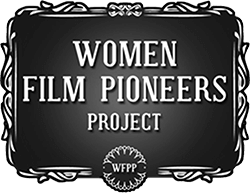
This digital project provides lots of resources on its website, posted by many university researchers. We can find online a large bibliography of sources related to early cinema more broadly, as well as different national silent film industries and histories. In addition to that bibliography, we have access to the entire list of the works and primary sources made by the pioneers. Indeed, many of the women presented on the website produced their own writing and published content, like film reviews, screenwriting manuals, novels, plays or illustrations. The other page that came to my attention is a list of Silent Film Organizations, Festivals and Conferences that try to preserve and exhibit silent cinema, and/or the work of early women filmmakers. Also, a lot of movies directed, produced and/or written by these women are listed with a link to watch them on streaming. Finally, several very interesting essays have been published on the website and address issues like “African American women in the silent film industry”, “French film colorists”, or “Writing the History of Latin American women working in the silent film industry”. But beyond all these great resources, the portraits of those women are still the most important part of the project. For each pioneer, researchers try to establish the most exhaustive biography, add the bibliographical source and present the integrality of their work.
This project, by promoting the work of women that have been overlooked in the history of early cinema, is truly important and we must give more visibility to this website. The work of Alice Guy-Blaché has only been rediscover a few years ago and it is time now to reinstate these women’s work in cinema history. The art of cinema could not be made without actresses, women producers, screenwriters and directors. This project needs a better recognition, and all these women deserves to be better known.
Have you ever heard about Tazuko Sakane, the first female director in Japan? Do you know Clara Kimball Young, the second female film star after Mary Pickford to set up her own namesake production company, the Clara Kimball Young Film Corporation? Or do you know Tressie Souders, the first African American woman director?
Well, click on the link → https://wfpp.columbia.edu/pioneers/
Julie Haudry-Hurault
0 notes
Text
Concerning Jazz Music
A complex debate
An important debate about jazz music affects the question of its ethnicity and its history. As jazz began to develop at the turn of the twentieth century, many people wondered how it would influence representations of white people about the African American community - with which jazz was usually associated. For some African-Americans, jazz music highlighted the contribution of black people to American culture and society, and has drawn attention to black history and culture. Others believe that music and the term “jazz” are reminiscent of an oppressive and racist society, which restricts the freedom of black people.
The various forms of music developed by enslaved Africans in North American and their descendants were rooted in Africa, particularly West Africa. There are several music behind jazz. The music genre was born from the work songs of the slaves. It also includes the music later known as the blues, which expressed hopes and pains of people. Moreover, St. Louis had been a center of ragtime, one of the musical tributaries of jazz music, at the beginning of the century. “Jazz,” according to the pianist Dave Brubeck (speaking in 1950) was “born in New Orleans about 1880” consisting of “an improvised musical expression based on European harmony and African rhythms.”
The term of « jazz » has a contested employment. The musician Max Roach didn’t accept the word : in 1972, he said that he prefered to describe the music as « the culture of African people who have been dispersed throughout North America […] jazz meant the worst kind of working conditions, the worst in cultural prejudice, the worst kind of salaries and conditions that one can imagine … the abuse and exploitation of black musicians ». Later, it was the turn of Artie Shaw : in 1992, he said that the word « jazz » was ridiculous. Archie Shepp also explained to Franck Cassenti in Je suis Jazz that he didn’t like the word neither. Whatever the case, it appears that the first authenticated appearance of the word “jazz” in print was in a newspaper, the San Francisco Call, on 6 March 1913. Originally, the term used to describe this music was associated with sex, and it was seen as a negative connotation.
New Orleans is famous because it’s the place where brass bands were born . The first jazz recording was released in March 1917 by the Original Dixieland Jass Band, an orchestra composed exclusively of white musicians. The pianist Jelly Roll Morton calls himself "inventor of jazz". If he’s indeed a ferryman between ragtime and jazz, it’s Sidney Bechet and especially Louis Armstrong who stand out as the great soloists of the New Orleans bands, characterized by collective improvisation. Jazz categories include Dixieland, swing, bop, cool jazz, hard bop, free jazz, jazz-rock, and fusion. The first jazz-style to receive recognition as a fine art was bebop, which is mainly instrumental and was formed by black jazz musicians during the late night jam sessions. Bebop evolved in the 1940s and was said to have been created by blacks in a way that whites could not copy.
Until recently, the question of the "belonging" of jazz music to white musicians or black musicians has been highlighted by actual jazz musicians. For example, Jacob Collier published on his Instagram account these words (on June 2020):
In the past few days, I have seen just how much power a white voice like mine has to detract from the truth and contribute to the noise, but what I can say with certainty is this : racism is a problem – in the UK, in the USA, ans across the world at large. Those who deny this, and are unwilling to engage with it, are the fabric of the probleme. As a white musician, I walk a path each and every day that has been trail-blazed, paved and illuminated by the colossal, unshakable legacy of black musicians stretching generations before me : the master alchemists, who transformed unspeakable suffering into everlasting power and music.
In the same way, another famous white musician, Jamie Cullum, wrote this, also on June 2020:
I remember when Twentysomething came out in 2004 I used to receive a lot of old fashioned paper mail. There was one short letter that asked me to consider what it meant to be a non-black musician, profiting off of generations of black artistry and culture. The reason I bring it up now is because I remember so clearly how it wasn’t a conversation I was ready to have with myself, as a 23 year old. But these are exactly the kinds of conversations that need to be had by people like myself, by all of us, however uncomfortable.
Both of them underlined that the soul of this music is connected to the roots of the generation that came before us. They explain how it’s important to considere the complexity of this culture and the history.carried for years. It’s important to not avoid or erase the question for the next generation. Of course, jazz music has created a sense of fellowship between black and white musicians. White musicians were hired to perform with several black bands (for example, Roswell Rudd was introduced to jazz audiences by Archie Shepp). It has not only integrated people in the United States but also brought them together, in the entire world, integrating international ideas into the music. But discrimination has existed, and still is.
Social effects of jazz music
In the 1920s, jazz became popular when the music began to spread through recordings. Some black jazz musicians believed that they didn’t get full recognition and compensation for being the inventors of jazz as African American culture. Furthermore, some people oppose the idea that jazz was invented by blacks.
Gradually, opportunities were given to black musicians by the radio and recording industry. Popular black bands were promoted as long as there was a demand for jazz music by white Americans. Some of these jazzmen (and women singers) received recognition as serious artists and several were invited to give concerts in Carnegie Hall, but still encountered criticism and racism. To some extent, jazz music would not have been widely distributed to the general public without the recording industry. However, black jazz musicians were less credited for their innovation of jazz music.
Many musicians expressed their demand for identity, self-expression and community, participating to the « Black Arts Movement » in the 60’s and rejecting the white western gaze. It consists on using slang in literature, the orality rhythm of the blues or the gospel in music. They fight for the destruction of racist stereotypes and some of them conceptualized the « blacknes ».
Artists’ voices in the Civil Rights Movement
In 1939, Billie Holiday’s rendition of Abel Meeropol’s poem, Strange Fruit, described the horrors of Jim Crow ‘s era lynching. The song is often considered as the first and most influential jazz protest song.
Southern trees bear a strange fruit
Blood on the leaves and blood at the root
Black bodies swinging in the southern breeze
Strange fruit hanging from the poplar trees
Pastoral scene of the gallant South
The bulging eyes and the twisted mouth
Scent of magnolia, sweet and fresh
Then the sudden smell of burning flesh
Here is a fruit for the crows to pluck
For the rain to gather, for the wind to suck
For the sun to rot, for the tree to drop
Here is a strange and bitter crop
youtube
Decades later, while governments and individueals attempted to silence the black political voice, jazz became a way of deep expression. Many jazz musicians became outspoken activists, they made their voices heard and started creating soundtracks to support the Civil Rights movement. Indeed, huge cultural and political shifts were underway in the form of the civil rights movement, which sought to break down the existing social order. Evolving in parallel by similar cultural and historical questions, the civil rights and jazz movements (especially the avant-garde) influenced each other.
John Coltrane, Charles Mingus, Nina Simone and some jazz pioneers made their voices heard during the civil rights movement. For instance, Coltrane was deeply involved in the movement and shared many of Malcolm X’s views on black consciousness and pan-Africanism, which he incorporated into his music. In the 60’s, he was at the height of his career. He performed a song (in fact, a dirge) in 1963, called Alabama, to mourn the Birmingham church bombing that took the lives of four little girls.
In 1964, Nina Simone sang the incendiary song Mississippi Goddam (responded to the 1963 murder of an activist, Megdar Evers) in front of a white audience at Carnegie Hall. The song starts off as a jaunty musical tune, before it evolves into an documentation of racial inequality in the South. In the recording, we can understand that the atmosphere of the concert is changing, as the public realize the intentions of the song. She used her lyrics to prolong her political commitment. She has also composed another famous song, Four Women : it highlight four specific stereotypes about black women.
youtube
Charles Mingus, for his part, wrote a song called Fables of Faubus about Orval Faubus, a racist governor of Arkansas, who infamously ordered the Arkansas National Guard to prevent black students from enrolling at Central High School in 1956. Mingus’ record label, Columbia, felt the lyrics were too incendiary, so he released the full version of the song on a record for another label.
To conclude this theme, I want to share an excerpt written by Dr. Martin Luther Link about jazz, for the Berlin Jazz Festival, in 1964 :
“God has wrought many things out of oppression. God has endowed creatures with the capacity to create-and from this capacity has flowed the sweet songs of sorrow and joy that have allowed humanity to cope with the environment and many different situations. Jazz speaks for life. The Blues tell the story of life’s difficulties, and if you think for a moment, you will realize that they take the hardest realities of life and put them to music, only to come out with some new hope and sense of triumph. This is triumphant music.”
This quote, from one of the most important figure of the Civil Rights Movement, underlines how jazz music has been a powerful form of art, but also a very political one, fighting against racism and advocating social, economic and political equality.
Anne Vinet
0 notes
Text
Mosco’s Last Documentary: Mafia, Politics and Corleone…

Mosco Levi Boucault is a documentary film director born in post-war Soviet Bulgaria, who arrived in France at the age of ten.
Among his many accomplishments, we can mention Des terroristes à la retraite : Ni travail, ni patrie, ni famille about the armed resistance in Paris and Toulouse between 1940 and 1944 and Mémoires d’ex, which tells the story of the French Communist Party from its creation in 1920 to the fall of the Berlin Wall through the fates of three generations of militants who were excluded from it.
In 1998, he began a series of documentaries presented as detective films that follow in their entirety investigators confronted with cases that range from the runaway of a minor to murder; the result is three documentaries: Un crime à Abidjan, La fusillade de Mole Street which takes place in Philadephia, Roubaix, commissariat central, affaires courantes. Also, Un corps sans vie de 19 ans, which reconstructs the fate of a young Bulgarian girl found dead on the Paris ring road, and Ils étaient des Brigades rouges, in which he gives voice and face to four former Italian terrorists who participated in the 1978 kidnapping and murder of statesman Aldo Moro.
In 2019, Mosco signs Corleone: a history of Totò Riina, a tragediatore (a man who sows discord in Sicilian) who, after three Mafia wars and hundreds of deaths, becomes the absolute leader of the Sicilian mafia at the age of 42.
Mosco likes hot topics. The project to make a film about Corleone (Toto Riina's birthplace) was born out of a conversation with the director of the Palermo Criminal Investigation Department. Mosco compares Francis Ford Coppola's Godfather to a Greek tragedy and evokes the mythical resonance of the name: Corleone, Heart of a Lion. The policeman replies, while Corleone here evokes only a dark, barbaric and bloodthirsty reality, far removed from the director's romantic vision. Mosco says that "From there was born the desire to investigate and deconstruct the myth. He then moved to Palermo and researched his subject for five years. Every day he went to the Gramsci Institute to find the newspapers of the time and took an interest in the archives of the Rai, the Italian public television.

This film is not "only" a tribute to the murdered judges Falcone and Borsellino and all those who lost their lives in the fight against barbarism; it is not "only" a quasi-surgical exploration of Cosa Nostra in the socio-political and cultural context of the time; nor does it merely explain how Riina chose the strategy of terror, preferring military confrontation to the usualcorruption, nor does it alleviate the collusion between politics and crime. It goes even further, it shows what no one had ever dared to show, making a dizzying plunge into the mentality of the Mafia "workforce": why and how one becomes a killer, how one goes from executioner to victim and vice versa. We thus discover the role of the Mafia's "social elevator": before entering it, "you are nobody" explains Anzelmo, one of Riina's right-hand men, then you become someone, a "man to respect", a man that your own clan respects and boosts.
Here's what's remarkable about Corleone: the coexistence of an overall point of view - which dissects and puts events into context, from the appearance of the first Mafiosi due to the recklessness of the great Sicilian landowners, to the fall of Totò Riina, through the Mafia wars - and from an individual point of view, which digs deep and presents testimonies, "lives", without passing judgment, subtly suggesting that there is in most men a desire for redemption, for everyone a possibility of redemption. It is, in the midst of so many horrors, in the face of the sordid reality of death by assassination, a glimmer to which we must firmly cling, just as we cling to the courage of the magistrates and policemen who, in the wake of the unforgettable Judges Falcone and Borsellino, Chinnici and Caponnetto, continue to fight, under threat, against evil and chaos.
Antoine
0 notes
Text
The Band Wagon, A Reflexion about its own Medium
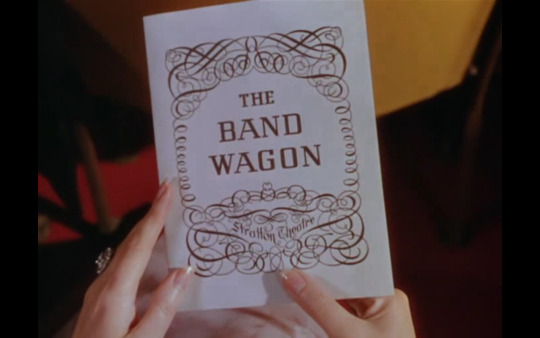
Today, we are going to focus on The Band Wagon, an American musical film, which came out in 1953 and was produced by Metro-Goldwyn-Mayer. Directed by Vincente Minnelli, starring Cyd Charisse and Fred Astaire, The Band Wagon is a significant example of what was known as the classical musical golden age in Hollywood productions. In the same spirit of Singin’ in the Rain, produced one year before by MGM, The Band Wagon’s plot turns around the entertainment industry: the creation of a musical-show named The Band Wagon on Broadway. This genre of musical could be named backstage musicals. It’s a very creative way to integrate the dancing and singing moments in the narration of the movie. In The Band Wagon, lots of musical moments are shown in the last thirty minutes of the movie, when the show is on the road. The end of the movie corresponds to the New York opening night of the show, that the audience followed during the whole movie. Then, backstage musicals created an intimacy and collective sentiment with their audience. Like an invitation to the audience to discover the other side of the shows.
The Band Wagon tells the story of Tony Hunter, a famous dancer and singer with humble roots who met a great success few years back on the stages of Broadway and then in Hollywood. After three years without starring in movies, Hunter is back in New York with the hope that a Broadway show will restart his career. This show is a musical written and composed by a Hunter’s old friend.To direct it, they had chosen Jeffrey Cordova, a trendy director on Broadway. Hunter’s characters announced by two sequences with a great suspenseful effect.
The first scene of the movie takes place in an Auction sale: the Bullwinkle Galleries in Los Angeles. The first lot of the auction contains Tony Hunter’s hat and stick. He used these costumes on Broadway. The auctioneer is obviously an enthusiastic speaker: “Perhaps the most famous top hat and stick of our generation. Yes, the one he used in Swinging down to Panama and all his other famous picture”. It’s quite funny to see that the auctioneer’s attitude is totally ostentatious. He proposes a low price to start the auction: “Let’s start with $5. Do I hear $5.” Nobody bets and then he devalues it: “All right. Let’s start with $2… Well? 50cents? Anything?”. Even at fifty cents, nobody proposes a new price…
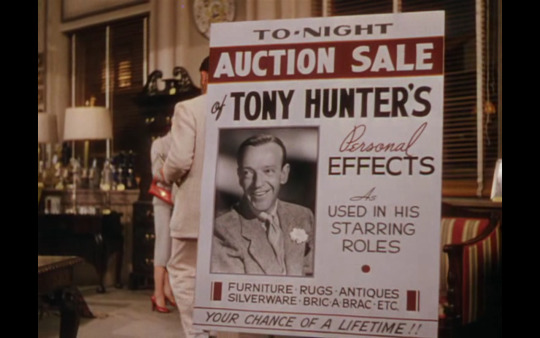
Then, the next scene brings us inside a chic classy train on its way to New-York. Two men are drinking and speaking about California, the cinema and actors. In the magazine he’s reading, one of the men points to a picture and asks to the second if he knows this actor. The second man acquiesces and answers: “Oh him. The singing-dancing fella. He was good twelve or fifteen years ago”. In the background, a man who’s reading a newspaper speaks up: “He’s washed up. Hasn’t made a picture in three yearS”. We can’t see his face because he’s hiding behind the big pages of his newspaper. The mysterious man continues: “That Tony Hunter’s a has-been” and then he puts the newspaper down on the table, showing his face: it’s Tony Hunter himself.
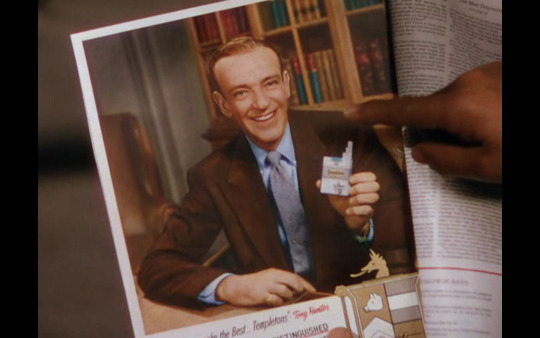
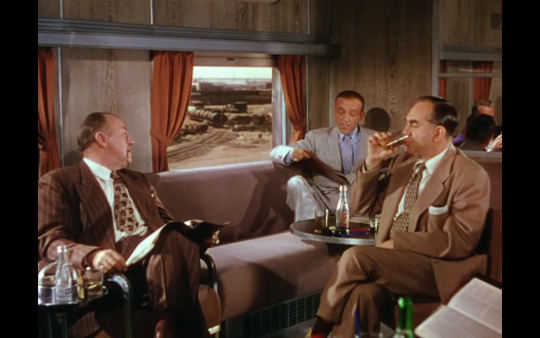
The third sequence concerns the moment Hunter is getting off the train, in the New York train-station. There’s a mob of photographers and reporters on the train platform. Hunter’s first reaction is that all the people are waiting for him. He gets out of the train and says: “Hi fellas, thanks for the red-carpet bit. I didn’t expect it!” This moment is the occasion to understand precisely why Hunter came to New-York: “Morton had something planned something for me. I haven’t been on the stage in a long time. And you get into a different medium…” He can’t finish his sentence. Reporters and photographers interrupt him to welcome the person they were waiting for: the actress Ava Gardner.The use of a real actress name is an intelligent way of mixing reality and fiction. In the middle of the fifties, Ava Gardner was a young and famous Hollywood actress while Fred Astaire was in his mid-fifties. After that, we can see the first musical number of the movie: “By Myself”. This first musical number ends the presentation of Tony Hunter, and is a good abstract of the three first sequences of the movie: an old-fashioned actor is coming back to his first love (the stage on Broadway).
Antoine

0 notes
Text
Short Of The Week: An Online Platform For Short Film Lovers and Directors

Short Of The Week (S/W) was founded in 2007 by Andrew Allen and Jason Sondhi. Originally, a new short film was displayed once a week on the platform; today, you can discover new short films everyday. The founders decided to keep the original name, as a kind of Madeleine de Proust and also because S/W is becoming an major reference for filmmakers who begin on the internet.
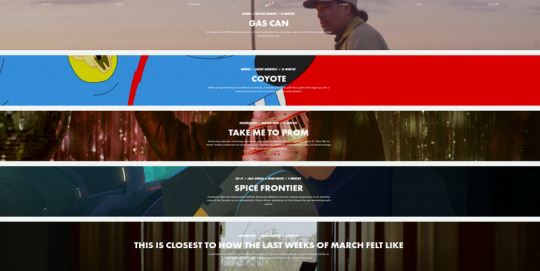
As you may know, movie directors mostly start their career with ‘’smaller’’ projects like short films. Those can be screened at movie theatres, as part of an ‘’avant-séance’’ or as a festival competitor. But the web is a huge launchpad for creators to show their work, especially regarding this specific content: professional or amateur, anyone can publish their short film on hosting websites and reach an audience, big or small.
The aim of Short of the Week is to showcase this content by making, as they state it, ‘’a new kind of festival’’. Indeed, for 29$, directors can submit their short film to the plaform’s staff who will then make a selection and decide which films will be featured; according to S/W, around only 4% of the submitted content is accepted. This is a rather small rate, but as in any festival, proposing your film doesn’t guarantee that it will be screened. It is also a ‘’proof of quality’’: as a viewer, you know that the films were culled by a staff of programmers so that you have innovative, impressive, creative and any-other-positive-adjective short films that are just waiting to be seen by you, but also by festival programmers and audiovisual professionals. They have various selection criteria, and they prefer movies that have not been screened on the internet or anywhere else yet.

The platform also support filmmakers by publishing the new featured content on their social media like facebook, twitter, or their youtube channel. They also spotlight the creators who made it to bigger live events, who directed feature-films… in short, those who started by submitting to S/W before their career propelled. Well, they more or less put the best stories forward, but honestly, this is normal thing to do when you need to finance your project. They also offer to partner with brands to help expand the platform and reinforce the professional support given to filmmakers and not just give them access to an audience. They recently partnered with Michael Sugar, who runs Sugar23, an investment company, but also with Cary Fukunaga and Gordon Green – you can find more about it here or here.

Moreover, S/W works to provide and promote the short film industry as much as possible, by helping directors, covering dedicated festivals and linking to films available online – as they did with the SXSW (South By South West) Film Festival in Austin, which has been cancelled due to the health crisis. For example, they featured eight movies that were supposed to be screened during the festival on their website so that they can reach an audience and have the proper visibility they deserve. Ten days later, they linked to another website created by independent distributors, where you can find a broader selection of SXSW films put online with the creators’ authorisation.
During lockdown, they created the #ShelterShort initiative. The guideline was to make a short film following only two rules: you have to film where you are sheltering and only with the people you are stuck with. The results are impressive!

I think this platform is really interesting because it truly adapts to (online) constraints specific to the short film industry and the need for a generation of filmmakers to be seen. It also is an awesome website to browse if you are tired of Youtube’s video suggestions, lead by an algorithm, or simply if don’t know what to do. It’s completely free to watch and most of the movies are qualitative. The range of genres, styles and storytelling is broad and diverse, and you can discover films from all around the world – with subtitles when the language is other than english. I just hope it will stay the way it is now and won’t become too ‘’commercial’’, even if it is a very specific market that has its own needs.
Enjoy!
https://www.shortoftheweek.com/
- Abigail
0 notes
Text
What can Silence Say? (Part 4 : Silent Endings) A Case Study of Arabian Nights, Miguel Gomes (2015) and The Nothing Factory, Pedro Pinho (2017)
The idea of studying silence in those talkative films actually stems from the silent endings in both films. Both come has a surprise for the viewer. The idea here is to show that silence is still a way to express oneself, and ultimately, to say something.

In The Nothing Factory, language slowly deplete. The last discussion between two characters ends with « And when this is over, we’ll see ? » (screenshot). Both characters don’t have anything to add. The song played during the last shots and the credits, called « Já Tempo o Habitua », sang by portuguese musician and activist José Alfonso, is quite pessimistic. The song focuses on the hopelessness of the ones fighting for freedom (https://www.youtube.com/watch?v=r6Eb-vnn79U). And even though that sounds grim, we have to put this scene in the context of the ending : the factory has been saved and the workers have managed to keep their jobs.
The last scene in Arabian Nights, is a long travelling following a bird-trapper. He walks alongside a road in the countryside, alone (screenshot). The only thing we hear is a song, « Calling Occupants of Interplanetary Craft », sang by children. The lyrics are a call to aliens, to make them come to earth « And please come in peace we beseech you / Only a landing will teach them / Our Earth may never survive / So do come, we beg you / Please interstellar policeman / Won't you give us a sign / Give us a sign that we've reached you » (https://www.youtube.com/watch?v=x8wykEr8rqs). Those lyrics are quite pessimistic towards the future of our planet, but because it is sang by children, which represent the future, we still get a sense of hopefulness.
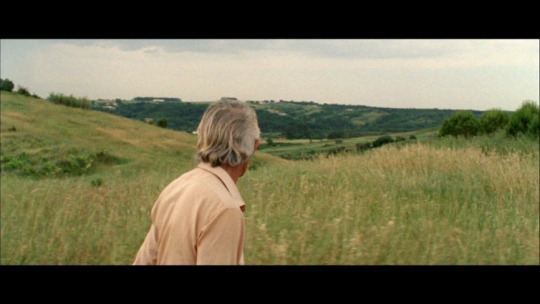
What both those endings bring is a sense of ambiguity. The viewer has to decide its meaning. Even if the characters don’t say anything, their choice to keep quiet means something, it says something to us. Those ending are not where language fails, but where it is radicalized. By being quiet, they say more than they could say with words. It’s leaving a space for reflection. As we saw, those films embrace silence as a way to show us a more poetic world : silence is a way to listen to the world around us.
But then, what does the choices for the music means ? In my opinion, those songs are both symbolizing how difficult it can be to fight for a better world. This can lead to despair in the José Alfonso song, or calling for help to an unknown and silent universe. But both songs also carry hope. As it turns out, José Alfonso never stopped fighting until his death in 1987, 13 years after the end of the Estado Novo, which ended with the Carnation Revolution. His songs were sang by protesters during the revolution. So despise the difficulty of this fight, in the end, he, and the portugeuse people won. The film doesn’t hide the fact that self-management and overall fighting against injustice is hard, but it is worth the fight.
0 notes
Text
Blockbuster
Created in 2005, the Belgian theatrical troupe Collectif Mensuel questions the notion of civic responsibility and the role of theater as a public service. Their plays deal with serious social and political topical thematics through parody and humour. One of the Collectif’s latest creation, Blockbuster, is a free adaptation of a novel by Nicolas Ancion, a Belgian author who regularly works together with the troupe.
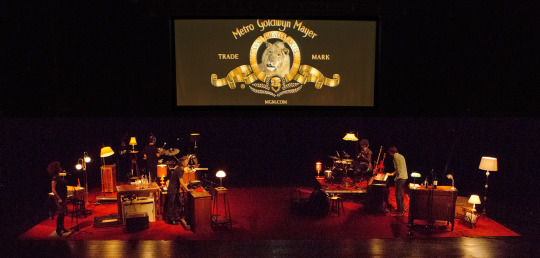
On screen, the mythical MGM’s Lion roars. Then follows an ensemble film telling two parallel stories that converge around the rebellion against austerity and inequalities when a popular insurrection brewing on social medias spills over into the streets. A new tax on high income contemplated by the government annoys an indecently wealthy CEO who will do anything in his power to prevent it. In the meantime, an investigative journalist is fired because her latest article denounces companies evading taxes with offshore funds.
If the movie contains all the ingredients of a blockbuster -- a righteous heroine fighting an unethical and powerful adversary, high-speed pursuits, spectacular explosions -- it’s partly because it is composed of over 1400 shots from 160 actual Hollywood blockbusters such as Wall Street, Kill Bill, Rambo, Erin Brockovich, Fight Club.
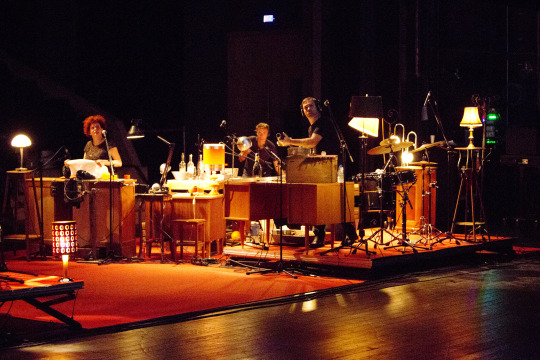
On stage, beneath the screen, stands a vast array of music instruments and more ordinary objects: desks, lamps, crates, bottles, glasses, newspapers, and so on... In this strange laboratory five actors-musicians create live the entirety of the film’s soundtrack: dialogues, music, Foley.
In this handmade rendition of the sound effects, a hot water bottle rubbed on the flat surface of a desk sounds just like the screech of tyres. While two musicians are in charge of the score, the seamless vocal performance of the comedians allows them to personify in turns a dozen of Hollywood’s most bankable actress and actors, amongst which are Julia Roberts, Judi Dench, Sean Pean, Michael Douglas, and Sylvester Stallone.
youtube
Making something new out of existing material is an artistic practice as old as the world, and using scenes from preexisting movies in parodic editing is a common practice on the Internet nowadays. Here, the mashup takes colossal dimensions since the movie lasts 80 minutes, and is doubled by the live performance of the artists.
Blockbuster offers a twofold performance to the audience, where entertainment and satire on capitalism coexist joyfully.
Raphaëlle Normand
0 notes
Text
«Ciné-Journal Suisse»: a Journey through the Cultural, Political and Social history of Switzerland from 1940 to 1975

Today, I’d like to present a third initiave aimed at sharing the audiovisual heritage. This time, however, I won’t speak about movies like in my two last articles (Filmo& Play it again festival), but about newsreels, and particularly about the web posting of the Swiss newreels «Ciné-Journal suisse» by the Cinémathèque Suisse, Memoriav (association for the preservation of the Swiss audiovisual memory) and the Archives fédérales suisses

Produced from 1940 to 1975, the Swiss newsreels were shown before the screening of the movies in the movie theaters in order to share the news of the week with the audience. These newsreels were created in order for Switzerland to be less dependant on the newsreels of the neighbouring countries, especially the fascist and Nazi newsreels. However, created at the request of the federal council (Switzerland’s national executive), which had full powers at that time, the newsreels represented the Swiss authorities’ point of view and propagated in particular a discourse on spiritual defense. During the Second World War, cinemas were obliged to show thenewsreels before the screening. After the Second World War, these newsreels continued to be on the line of the federal council but cinemas were no longer obliged to screen them. Then, at the beginning of the 70’s, the newsreels were shot by young filmmakers and «the reports were often critical of society, sometimes even satirical»[1]

Given the rich material that these newsreels represent for the study of the social, cultural and political history of Switzerland, as part of the collective audiovisual memory of Switzerland, the Cinémathèque Suisse, Memoriav, and the Archives fédérales Suisses have decided to make the content accessible on the platform Memobase[2](a web platform run by Memoriav which hosts more than 400 000 Swiss audiovisual documents). The project of the newsreels’ web posting began in 2015 and should have been completed in 2019, but it seems that the first years (1940-1950) and the last ones (1970-1975) have not been put online for the moment. The entire collection contains more than 6000 topics and about 200 hours of film. On the website Memobase, you can watch every newsreel in the national language of your choice (French, Swiss-German or Italian) and you can have a look at the digitized releases which accompanied the newsreels (as you can see below).
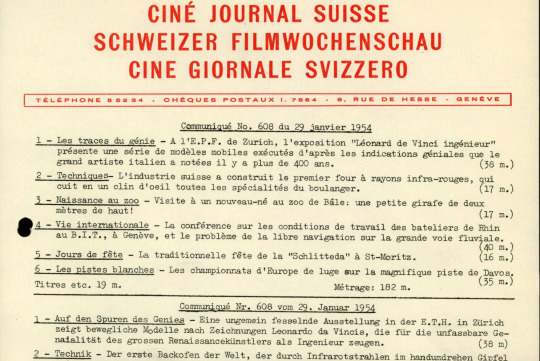
Manon
[1]https://hls-dhs-dss.ch/fr/articles/010478/, 30 mai 2020
[2]https://www.memobase.ch/fr/stock/detail/SFW_CJS_CGS-SFW_CJS_CGS, 30 mai 2020
0 notes
Text
Lost in La Mancha: the Story of a Film that doesn’t Exist
Keith Fulton and Louis Pepe, two American filmmakers were invited by Terry Gilliam in March 1999 to chart the production of his new film The Man Who Killed Don Quixote. Gilliam already knew the two filmmakers from the shooting of Twelve Monkeys, which they had recorded in their first documentary Hamster Factor and Other Tails of Twelve Monkeys. The filmmakers were thrilled at the opportunity. The metaphors couldn't have been richer: Gilliam, the fantasist, the iconoclast, fighting with his alter-ego, a character whose grandiose fantasies defined Gilliam's aesthetic. Fulton and Pepe intended to make a humble documentary about the development and pre-production of Terry Gilliam’s long-awaited passion project. It was supposed to be what’s called a « making of », shown in the bonus of the film DVD package. That being said, it was not the usual chronicle of Hollywood excess, rampant star egos, nefarious producers and so on. As a matter of fact, this movie, based on the picaresque Spanish novel Don Quixote of La Mancha was produced and financed exclusively with European funds (almost 35 million dollars, the most expensive European production at the time) and the money was in place, the talent supportive and disciplined, and the script finished and storyboarded.
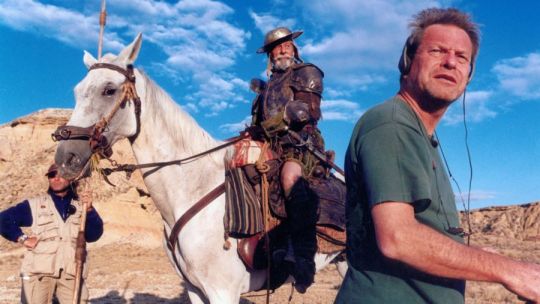
«Which is it, King Lear or Wizard of Oz?» (Terry Gilliam on the set of The Man Who Killed Don Quixote).
Piece by piece, the entire production fell apart. A series of events conspired to shut down the project altogether: rehearsals without any actors (some key contracts weren’t even signed!), a cavernous studio, booming with echoes for the indoor scenes, jet fighters interrupting the filming of a pivotal scene, and, in the climax of the documentary, a severe storm washing away equipment in a flash flood. Finally, the main actor, Jean Rochefort suffered a double herniated disc forcing him to stop the shooting, eventually conducing Gilliam and the producers to cancel the production.
When they started following the pre-production of the movie, Fulton and Pepe had no idea that the story would develop into its own quixotic tragedy. The documentary details and depicts the pre-production and the first (and only) six days of production of Gilliam’s ill-fated attempt to film The Man Who Killed Don Quixote and, what was expected to be simply a «making of » is now the basis of the film, itself as all these catastrophes were captured on film. The two filmmakers continued shooting, even after the interruption of the film: decisions taken in a hurry, discussions with the producers about the «force majeure» clause of the contracts, and, at the end, an insurance claim of 15 million dollars, the highest in European cinema history. The tragic irony of Gilliam's quest had outdone Cervantes.
«Someone has to get a film out of this. I guess it’s going to be you» said Gilliam to the two directors after the project failed, and actually Fulton and Pepe spent a whole year in post-production, meticulously reconstructing the story from the 80 hours of rushes they had. They had the idea to stage script reading scenes, to incorporate Gilliam’s storyboard and the few scenes taken from the brief shooting (especially the extraordinary scenes with the three Spanish «giants») to bring to life Gilliam’s Don Quixote. They created animations and special music (called Nino Rota goes to Corrida) to narrate the story of Cervantes’ novel and Gilliam’s career and at the end they succeeded in making us see a non-existent movie.
Lost in La Mancha, finally had a theatrical release in 2002. It was a big critical success despite the fuzzy aspect of the movie on a big screen. The rushes the filmmakers had were actually DV shots, as they never intended to make a movie for cinema. It nevertheless became quickly considered as a remarkable document of the difficulties inherent in the moviemaking process. It is surely the first «un-making of » of a documentary. In a genre that exists to hype films before their release or to create new content to sell DVD editions, Lost in La Mancha presents an unexpected twist: it is a record of a film disintegrating. This documentary constitutes an amazing document about relationships between art and the entertainment economy as it presents a unique and in-depth look at the harsher realities of filmmaking. It gives to the spectator an occasion to see the process of creation from the inside and gives a glimpse of its extreme fragility.
Claire
3 notes
·
View notes
Text
Museum’s guestbook: an imminent disappearance?
Within a museum or an exhibition, the guestbook creates a link between the institution, the artworks, the artist and the visitors. The classic visitor's book, usually a hardcover book, located in the last exhibition room, allows everyone to write whatever they wish in it. There are no rules governing writing: the time devoted to writing, the space used, the layout, the nature of the message or the addressee are factors that the writer totally appropriates. Hybrid objects of unconventional writing, invested by a diverse and anonymous public, guestbooks are rarely considered as an archive. Never representative, nor exhaustive, deeply subjective and partial, guestbooks struggle to be seen as historical documents. Yet, when an institution decides to preserve them, they stand the test of time and can become precious testimonies of an exhibition (and an era) that we have not been able to know. The guestbook of the exhibition "S.M. Eisenstein - 300 drawings", held at the Cinémathèque Française between April and June 1960, commissioned by Henri Langlois, bears witness to this. Freely available for consultation in the archives of the French Cinémathèque, the visitors' book records the venue of a whole community of film lovers and filmmakers who have left their mark on their century.
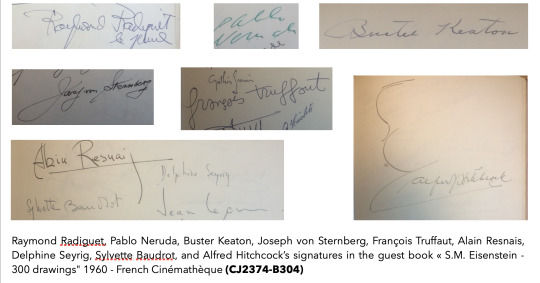
Although it can be read by everyone, the guestbook contains a great deal of information about the visitor. Recent guestbooks record many e-mail addresses, Instagram or Snapchat accounts, which visitors have written, in hope to be read (and probably found back). Thus, the relationship between visitor and guestbook seems positive, and the guestbook appears as a trusted object, through which it is possible to define oneself personally, without any imposed category constraints. By contributing to it, the spectator takes on the role of a witness. Like the advertising material and the exhibition catalogue, the guestbook is a permanent record of an ephemeral event. Leaving a commentary in such a book is also part of a self-centred process, which satisfies the need to affirm one's existence by marking the place of one's presence. It means: "It existed, because I was there. »
Today, these unique books tend to disappear. It is replaced by digital guest books that have appeared since 2016 in the form of an application (GuestViews), available on a digital tablet. Just like the classic guestbook, the application allows visitors to leave a comment about the exhibition. But before accessing this free space of expression (which is not that free, as the number of characters is limited), the user has to answer several questions about his or her sex, age, e-mail address, how he or she heard about the exhibition...
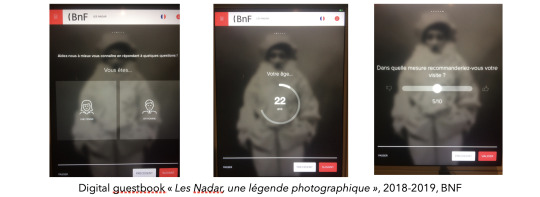
Thus, the possible spontaneity we had on the paper guestbook is replaced by a tedious, even discouraging interrogation. There is no more handwriting or drawing. Nor is there any communication between visitors’ comments, since the previous comments are only readable after having contributed. Moreover, the digital obsolescence and the content flow leaves little visibility on the durability of the content generated via GuestViews.
This new interest of the museum for the personal data of its visitors is ambivalent. On the one hand, the compilation and processing of this data enables the museum to improve its visibility among its public. Museums can thus adapt or target more accurately those categories of public that are absent from its institution. However, this intrusion of personal data into museum strategies can sometimes give the impression that museums are nowadays being managed more and more like big companies, which show less concern for the common good and the enhancement of collections than for profitability and performance.
Margaux Blondel
3 notes
·
View notes
Text
Bad Lip Reading - How Jokes Reflect Reality
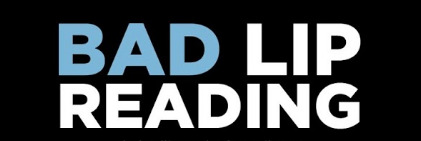
It has been a while since I wanted to talk about Bad Lip Reading because I love this YouTube Channel so much.
It is run by an anonymous author, called "The bad lip reader’’, and was created in March 2011. The creator of these videos started by making fun of video clips such as Rebecca Black’s ‘’It’s Friday’’ by creating a special music (a simple rhythm box with a few melodies) and lip-synching so that it matches the singer’s lip movements – but really poorly.
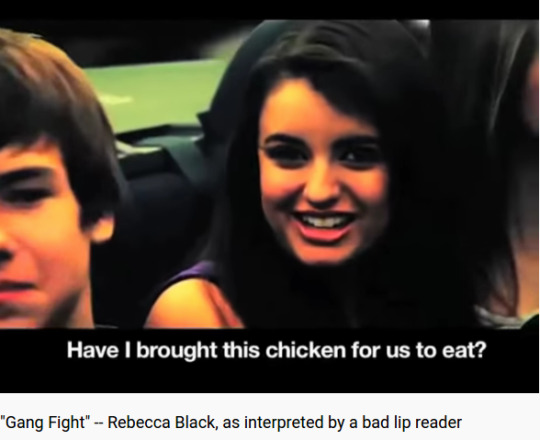
The content then extended to other types of clips – extracts of speeches, movie snippets, events… that are dubbed and sometimes ‘’songified’’. As the channel developed, generating millions of views, the videos got longer and more complex. Depending on the amount of work done, the publication rate goes from one to three months between each video.

Who is the BLR ?
I was wondering if the person behind this channel is one of the members of the Gregory brothers, who run Schmoyoho, a channel which songifies memes and other viral content. It also reminds me of Mario Wienerroither’s work, the man behind Silentless Movies, Musicless Musicvideos and Speechless Speeches. The sound design in these videos is just astounding and works really well. But this is just hypothetical and I think the Bad Lip Reader aims to keep the mystery relating to his identity for a while.
The subjects mocked by the channel are mostly linked to news regarding the United States of America, whether cultural (new TV series, new movies…) or political – for example, the most recent publication is about the State of the Union 2020. It was uploaded three months ago, hopefully there will be a new one soon…

I find it very interesting to see how successful the BLR videos are and how they can highlight the absurdity of a situation or of a personality – especially when it comes to politics. Believe me, BLRs of Donald Trump’s appearances are the best. I also think it is amazing to recreate a ‘’scenario’’ (even if it’s a bunch of nonsense) based on images with the constraint of having to tie in with how the characters’ lips are moving.
My personal favourite is the parody of the first Presidential Debate between Hillary Clinton and Donald Trump. The video is edited so that the result looks like a television game show. It gets me every time.
youtube
This use of archives is deliberately outrageous and at the same time, it encourages us to go and watch the original content (from where the videos come from) – they are displayed on the description below each of them most of the time. However, all this raises questions, considering the fact that we now have the power to edit and modify multimedia contents on various levels; a very advanced use of sound design combined with techniques such as deep fakes could lead to serious misinformation. But in this case, the parody is really obvious and the tone not so serious even if sometimes you surprise yourself, wondering which source is the original.
Technically speaking, I would really love to discover the making of such videos, from the choice of the parody to the addition of voices and sound effects. It must be such an effort to put this kind of thing up and I’m really glad this channel still has the success it deserves. On those sad days of post-lockdown, when one of the only reasons to go outside is work because everything else is closed, a good laugh does no harm.
- Abigail
2 notes
·
View notes
Text
The South African War Films Held at the BFI should be More Widely Used as Sources by Historians
The South African war (1899-1902) is one of the earliest conflicts ever to be filmed. It was a major imperial conflict involving the British Empire for three years, and it is considered as the first media war, with two hundred war correspondents sent to South Africa, for a more and more widespread and illustrated press.

Joe Rosenthal for the Warwick Trading Company, silent film, late May 1900, https://player.bfi.org.uk/free/film/watch-field-ambulances-crossing-the-vaal-river-1900-online, consulted on 3rd June 2020
Eight cameramen, all British, were sent to South Africa to shoot actuality films by three film companies: the British Mutoscope and Biograph Company, R.W. Paul’s Animatograph Works, and the Warwick Trading Company. Another company, Hepworth and co., only covered events in Britain, such as the landing of troops. However, a lot of staged propaganda films and fake actualities were also made in Britain (by R.W. Paul) and in other countries, including by Edison and Pathé. According to Stephen Bottomore, the total of staged films made during the South African war is at least twice that of those made during the Spanish-American war of 1898. Most of these films were lost. Today, only a few of them (sixty-five) are held by the National Film and Television Archive of the BFI, mostly 35 millimetres, lasting one minute in average. However, distributors’ catalogues of the time contain useful descriptions of the lost films. These archives are valuable testimonies which could be used more widely for the history of cinema and of its role in the development of propaganda in the media, especially the visual and audio-visual media. Indeed, the few studies which have been done on those South African war films reveal their potential.
The South African war was a turning point in the professionalisation of cameramen. It set their ambivalent role as a disturbing gaze limited by a stricter censorship, as well as new partners of the army, wearing khaki uniforms and accompanying the troops. There was definite self-censorship as well, through omission and the choice of subject. The Boers, enemies of the British, were almost never filmed (partly because they were engaged in a guerrilla warfare), except when made prisoners or surrendering. Filming the war was forbidden at the end of 1900 when the British army started to burn civilian homes and to confine Boer and African civilians into what was already called concentration camps. The professionalisation of cameramen also had consequences on the development of new filming techniques and storytelling patterns, as the archives show. Some of these patterns were inspired from earlier visual media already widely broadcast, such as the illustrated press, photographs, publicity, music-hall shows, or lantern lectures: they exalted the traditional values of heroism, chivalry, honour, displayed in all popular imperialist propaganda. The few shots of British wounded soldiers portrayed them as heroes, as the pro-war newspapers did. The shooting of daily army life, such as washing scenes, was destined to show how soldiers did their duty in a “civilised” way. However, new visual symbols specific to cinema were developed through this war. For example, a lot of films represented troops crossing rivers. Besides picturing an imperial landscape in a romantic way, as done traditionally by the imperialist imagery, river crossing came to symbolise a military advance. The raising of flags was also a new visual symbol frequently used during the war as well, in actuality films as well as in staged propaganda films. The latter also roughly portrayed British soldiers as heroes and Boers as villains, firing at Red Cross tents for example.
According to Elizabeth Grottle Strebel, these films show that propaganda films were at that time still crude and primitive, lacking the visual power and sophistication of the XXth century propaganda. Yet, to Bottomore, “they were pioneering exercises in presenting a ‘point of view’ on film”. In addition to the dramatisation through new visual symbols, actuality films as well as fake staged films were trying to be as realistic as possible to serve as proof. Raw documentaries, though almost never showing actual battles (for logistical issues), were mostly filming troops movements of various colonial regiments, as a testimony of the unity of Empire as well as of the imperial confidence shown by the physical bearing of the men (at a time when there was anxiety concerning the health of Volunteers). To Grottle Strebel, these films thus reflected “the dual preoccupation of the cinema at its birth, the realism of Lumière and the magic of Méliès. There is both the obsession with recording true events, albeit from a certain perspective, and the desire to make cinema perform feats, through editing and double exposure, to dramatize the ‘cause’”.
History of their reception can also inform the role of cinema at the time. Many of these films were shown regularly at the Palace Theatre Varieties in London, and were popular among the public, which makes them interesting to the historians focusing on the media coverage of the war and the way it was received. The majority of the people did not know which were faked and which were not. Like the music-hall shows and popular newspapers sometimes called “the gutter press”, the staged propaganda films were seen by some as sensationalist. The study of the way in which the films were shown, accompanied by music, and sometimes a commentary, can inform the specific strength of cinema, able to cause unprecedented emotional reactions. Indeed, the screening of South African films provoked patriotic outburst in Britain, and anti-British emotions in continental countries. Thus, it permitted governments to understand the power of cinema in provoking strong collective reactions, suitable or not to their purposes.
The BFI’s collection of South African war films would be worth being highlighted so that historians, especially those working on the war or on the media of that time, who do not naturally tend to this type of sources, could take these rich testimonies into account in their studies.
Esther Montanès
Bibliography
Luke McKernan, “The Boer War (1899-1902), Films in BFI Collections, National Film and Television Archive”, NFTVA Cataloguing Department, BFI, 1999.
Stephen Bottomore, “Filming, Faking and Propaganda: the Origin of the War film, 1897-1902”, under the supervision of F.E. Kessler, 2007 (thesis).
Elizabeth Grottle Strebel, “Imperialist Iconography of Anglo-Boer Film Footage”, in John L. Fell (ed.), Film Before Griffith, Berkeley, University of California Press, 1983.
0 notes
Text
Mick Micheyl: troubled gender
Anybody born after the 70’s may not have heard about Mick Micheyl, and that is a shame. Not only is she the writer and singer of the very emblematic «Gamin de Paris», but also a great cabaret artist, TV producer and philanthropist. Most of all, the almost forgotten celebrity who passed away a year ago deserves to be known for her genuine subversion of gender stereotypes on French television during the 50’s and the 60’s.
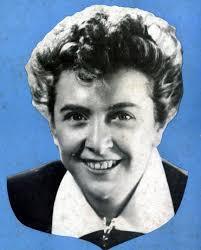
Born in Lyon as Paulette Michey in 1922, she attends the Academy of Arts during World War II. One of her hobbies is playing the accordion and songwriting. As she finds nobody to sing her lyrics, she decides to do it herself and ends up winning a radio song-contest in 1949. This enables her to set up in Paris the year after. At 28 years old she isn’t married (and never will be), and doesn’t show any particular appetite for what is considered feminine. She always wears her curly hair short, flat shoes, white socks, wide dresses with a white collar… That kind of un-sexualized scholarly look makes her regarded by her masculine audience more as a buddy than as a potential, to-be-seduced, future wife. Moreover her very particular white collar belongs to the lesbian dress code and iconography, whose codes are known only to that community.
In 1950, her most famous single «Un gamin de Paris» topped the charts immediately after its release and soon became an ode to the Parisian way of life. The song had so much success that it was covered by stars like Yves Montand. Once launched, Mick Micheyl’s career goes at a frenetic pace. She is invited in the world’s most renowned concert halls and is even asked to write a song for Grace Kelly and Prince Rainier’s wedding. However, she travels the world without changing anything in her rather masculine way of dressing and expressing herself, thus disrupting the patriarchal customs of her time, that claimed women belong either in the kitchen or should only be sexual objects dedicated to the pleasure of whomever owns them. As a sign of her refusal to abide to those rules, her lyrics are always un-gendered, so that even when she talks about love, nobody knows who could be the subject of her desire. However, she never came out publicly as talking openly about sexual orientation was admitted only later on, around the 90’s.
In 1963, Mick Micheyl becomes too old to play her buddy role, and Henri Varna, one of the Parisian Kings of the night, offered her the position of leading Lady at the Casino de Paris. She accepts the proposition and has to adapt to the radical feminine fashion standards of the time. At the age of 41, she loses over 20 pounds and learns how to walk in high heels. At the same time she composes a peculiar clown character with very athletics acts on a tightrope, so that, once again, she can’t be totally assimilated with the sexy but silly starlet.
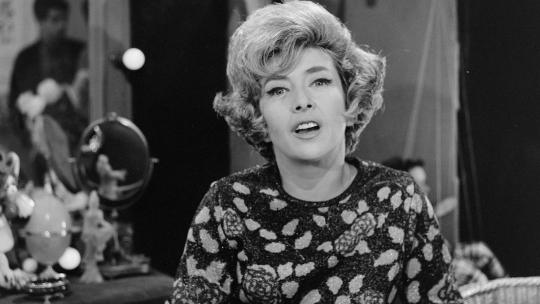
From 1969 to 1974 she works as a producer for French Television before disappearing from the screen in order to devote herself to her first passion: sculpture. During her passionate career, she always had two different audiences: the general public that loved to be entertained with very typical French songs and the lesbian community that could for once feel understood and represented, even in the national television that used to ignore (if not marginalize) them.
Margaux Blondel
3 notes
·
View notes
Text
Spy on Penguins to Further Science

Adélie penguins (photo: Tom Hart)
Citizen science, also known as community science or crowded-source science, is defined by the Oxford English Dictionary as “scientific work undertaken by members of the general public, often in collaboration with or under the direction of professional scientists and scientific institutions”. Involving the public in scientific projects is a way to encourage curiosity and improve understanding of science while providing help to gather and process data. The Internet and the development of digital technologies have vastly expanded the opportunities for citizen science. These projects mainly resort to participatory monitoring; namely collecting data through the observation of biodiversity, natural resources, or climatic phenomena in a particular area by its local residents.
Some projects also rest heavily upon the use of audiovisual media. For example, Les Herbonautes is an initiative from the French National Museum of Natural History to help botanists by searching the labels on the digitised pages of the Paris herbarium in order to identify where and when the plants have been collected.
Audiovisual media might be the only viable research solution sometimes, for instance in hostile or remote environments such as the Southern Ocean and the Antarctic Peninsula where the penguin colonies studied by Dr. Tom Hart, penguinologist at Oxford University's Department of Zoology, live. He leads the Penguin Watch project in collaboration with other international research groups. A network of over 50 automated cameras monitors colonies of gentoo, chinstrap, Adélie, rockhopper, macaroni, and king penguins by producing millions of images that the scientists will use to gather information about the birds’ behaviour, reproduction rates, and winter activity. However, in order to comb through this enormous amount of data, they need the help of volunteers.
As a part of Zooniverse, a collection of web-based citizen science projects, the Penguin Watch website gives access to time-lapse or aerial photographs taken by the monitoring cameras. By clicking on the pictures, the interface allows users to tag - and as such to count - the penguins (adults, chicks, eggs), as well as other animals such as seabirds, seals, or humans that might appear on the pictures. Eventually the volunteers’ works will also “teach” computer algorithms how to identify and count birds accurately.

Screenshot of the Penguin Watch interface
Until recently the focus was only on penguins, but two others projects will help broaden the scope of the research: Seabird Watch and Seal Watch.
Besides the workflows to mark animals, the website is also a well documented resource to learn more about the different species and their life cycle (see the ‘Field Guide’ tab on the right). The website also features a discussion board where the volunteers can interact with other citizen scientists and the science team.
Fair warning: counting penguins can be addictive.
Raphaëlle Normand
2 notes
·
View notes
Text
Birth Of The Cool
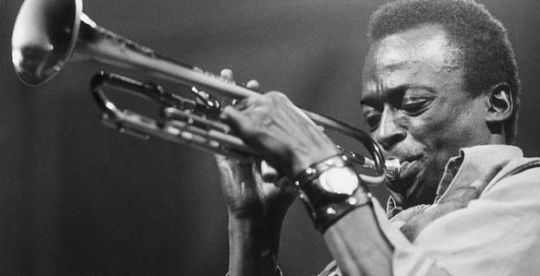
Miles Davis: Birth of the Cool is a documentary released by Stanley Nelson in 2019 about the jazz trumpeter, bandleader and composer Miles Davis. The idea of the project began about fifteen years ago. During an interview, the filmmaker expressed his surprise, because there's never been a biopic about Miles Davis. He thought it would make a great film because Miles Davis' life was anything but boring. Actually, Miles Davis is a really interesting character, and the film improves my understanding of the musician on the whole, because his artistic development, as well as his legacy, has been explored in detail.
In the documentary, Davis is described as someone who was always searching for a new form of musical expression, reshaping music, and then moving on to the next idea. For the last half of the 20th century, Davis' music reflected the evolution of jazz, from bebop to cool jazz to modal to fusion. He played with brilliant sidemen, including John Coltrane, Bill Evans, Herbie Hancock, Ron Carter, Wayne Shorter, Quincy Jones… Miles Davis was the equivalent of a rock star, but for jazz music. The documentary shows how popular and iconoclastic he was. It covers the main highlights of Davis' career, from his early years (that included playing with Charlie Parker) through the recording of several famous albums, such as Kind of Blue, Sketches of Spain and Bitches Brew (which introduced him to a rock audience), to one of his last public performances at the Montreux Jazz Festival in 1991.
During his career, Stanley Nelson has focused on various historical subjects, especially about African-American history. To him, this documentary goes beyond just being a musician's biography. Nelson had the endorsement of Davis' family, who made access to the film's interviewees possible.
The documentary is accompanied by a lot of archival footage, sometimes unseen images, photographs, studio out-takes, and a lot of music. But, in some way, the quantity of archival material becomes an impediment for the documentary.
To begin, we can underline the treatment of music in the documentary. Voice and music aren’t coordinated. In fact, I had the feeling that the film drowns the voices in the music, as if the filmmaker feared that too many musical performances heard without interruption for more than ten seconds would be impossible for the spectator. It results in the feeling that we can’t simply enjoy the music, even if it’s the main topic of the film.
Moreover, the documentary features new interviews with a wide range of people, for instance several of Miles Davis’ friends and former musicians (among them Lenny White and Marcus Miller), who knew Miles Davis personally. It also features the reflections of several writers and scholars, who bring knowledge about the social and political context of the area. A lot of information emerges from these interviews.
However, Nelson has made these interviews in the form of talking heads. Their remarks are often cut, delivering only specific pieces of information that drive the movie forward. It gives the impression that there’s no sense of dialogue between them and Stanley Nelson. We never see him, or hear his voice doing the interview. There is a lack of continuity, of spontaneity in the evocation of memories.
Furthermore, the documentary uses words from Miles Davis’ autobiography, yet Davis’ words are spoken by an actor, Carl Lumbly. Miles Davis had a very raspy voice, like the actor, who embodies Miles very well. At first, I thought it was an old recording of Davis himself.
Nevertheless, this text is cut too. It joins disparate bits to briefly deliver the desired information. An indiscriminate slew of still photos illustrate the spoken text, and for the most part, the filmmaker used the Ken-Burn effect, by zooming in on the images. The text overwhelms both the music and the images. Narration and music are playing at the same time as still photos (sometimes flashy visuals) and film clips crowd the screen in an illustrative montage, with no contextualisation.
In my opinion, the density of the material (archive footage, photographs, performances, interviews) doesn’t contribute to make the subject clearer. The use of archives is really questionable, and sometimes I felt lost among this material. There is maybe a lack of simplicity, even if the subject is captivating, even if the archives are beautiful.
(Anne V)
0 notes
Text
What can Silence Say? (Part 3: What Animals Have To Say) A Case Study of Arabian Nights, Miguel Gomes (2015) and The Nothing Factory, Pedro Pinho (2017)
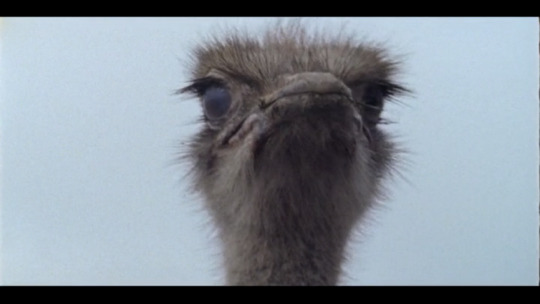
Both films use the presence of animals to say something about the characters and what they’re going through. When, in The Nothing Factory, Zé digs up guns from the Carnation Revolution with his dad, they run into ostriches (screenshot). This gives a surrealist tone to the scene, while also giving a metaphor of the buried violence of the revolution. The Carnation Revolution is often regarded as a peaceful revolution, with the famous pictures of people putting carnations on the guns of soldiers (picture on the right – anonymous, 1974). However, violence was a part of this conflict, targeting especially people of Cape Verdean descent. This was highlighted in the Pedro Costa 2014 film Horse Money. In this theory, the ostriches stand for the Portuguese people who refuses to acknowledge the violence of this Revolution. But the afore-mentioned scene can be analyzed in a different way. For actor Herminio Amaro, the character of Zé symbolizes anti-conformism, revolt and irreverence, whereas the ostriches are the ones that hide their heads in the sand, refusing to face a problematic reality.
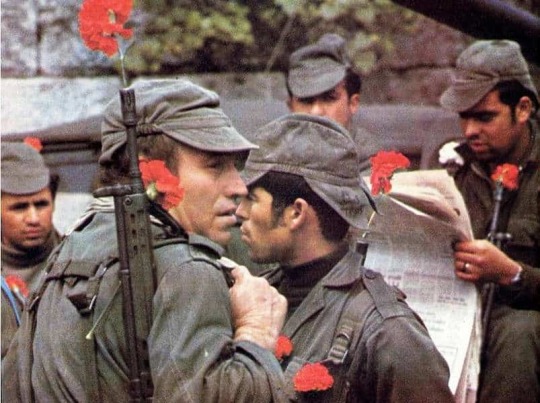
The animals play a bigger part in Arabian Nights, much like in the original tale. In an interview for Les Cahiers du Cinéma, Gomes stated that animals are a part of the community that he’s filming. In the first instalment, the segment «The Story of the Cockerel and the Fire» (screenshot), has a talking cockerel. The cock is talking and screaming to warn the humans of the fires around the region, but nobody takes the time to listen to a talking cock and it ends up in court. He is then silenced by the judge. Throughout the films, the animals seem to detach themselves from the world, whilst paradoxically having more and more screen time. Dixie the dog from the second instalment doesn’t care about the outside world and is just there to please his multiple owners. The chaffinches from The Enchanted One are just here to sing their songs. The bird-trappers have singing-chaffinch competitions and pay attention to their melody. This is also why all the bird-trappers that we see are always quiet: they are listening, paying attention to what their birds are singing, and this may be one of the core arguments of this whole analysis: what they’re teaching us, is that the choice of speaking is also the one of not listening. Listening doesn’t necessarily mean understanding or looking for meaning, listening can be just hearing the melody, the rhythm, the notes of a bird's song.
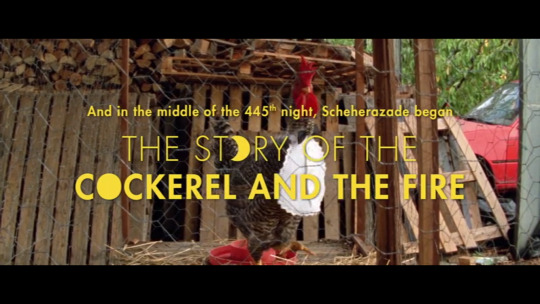
Joséphine
0 notes